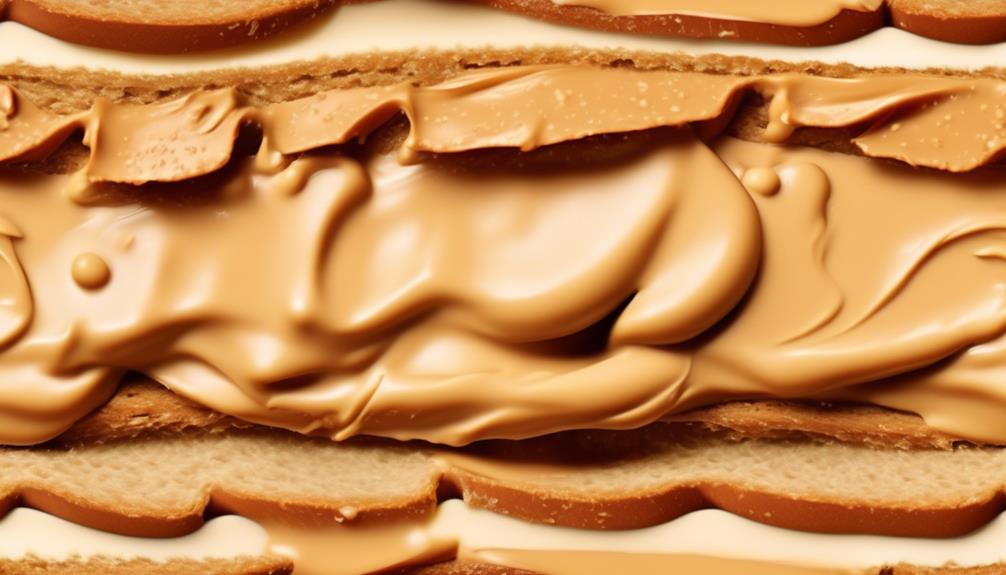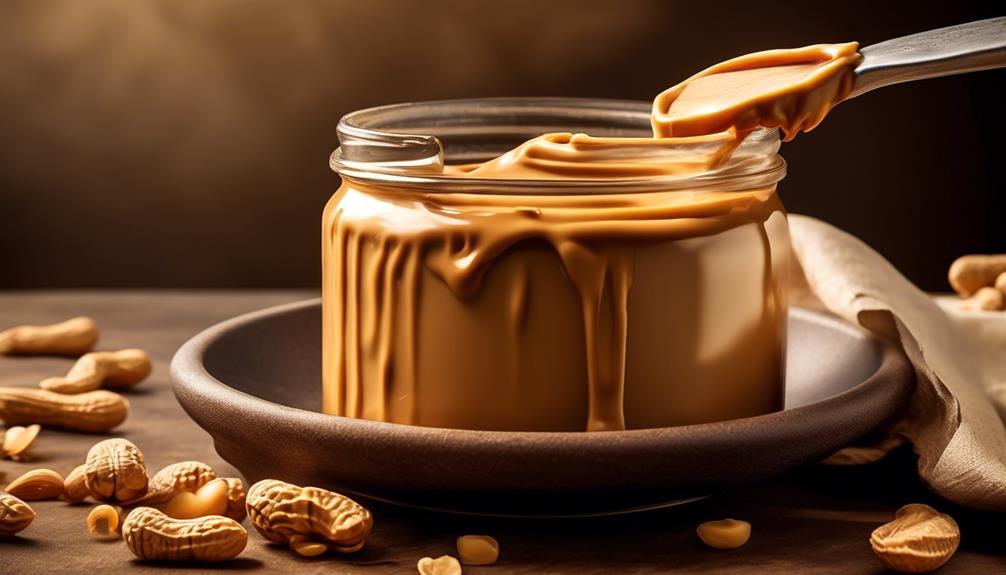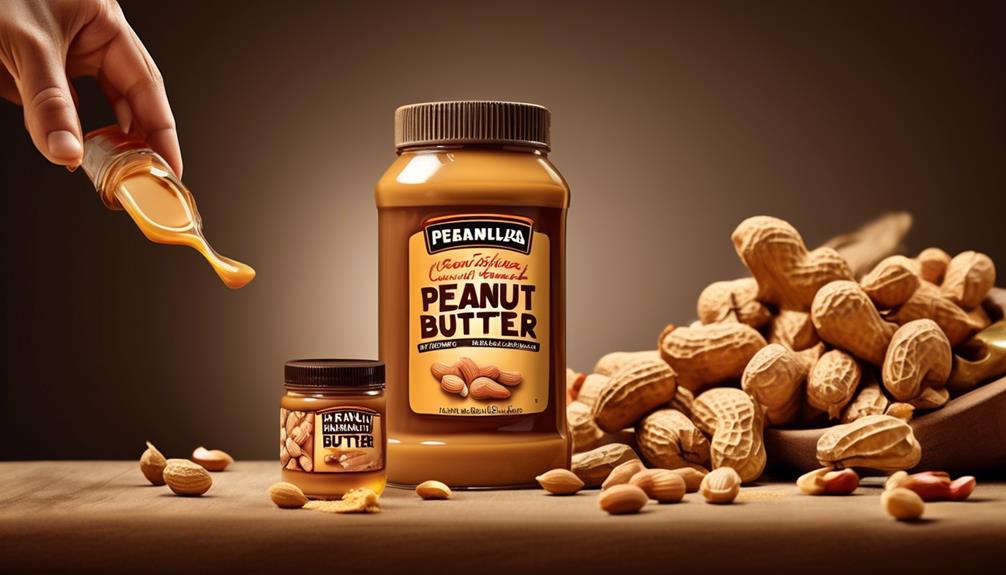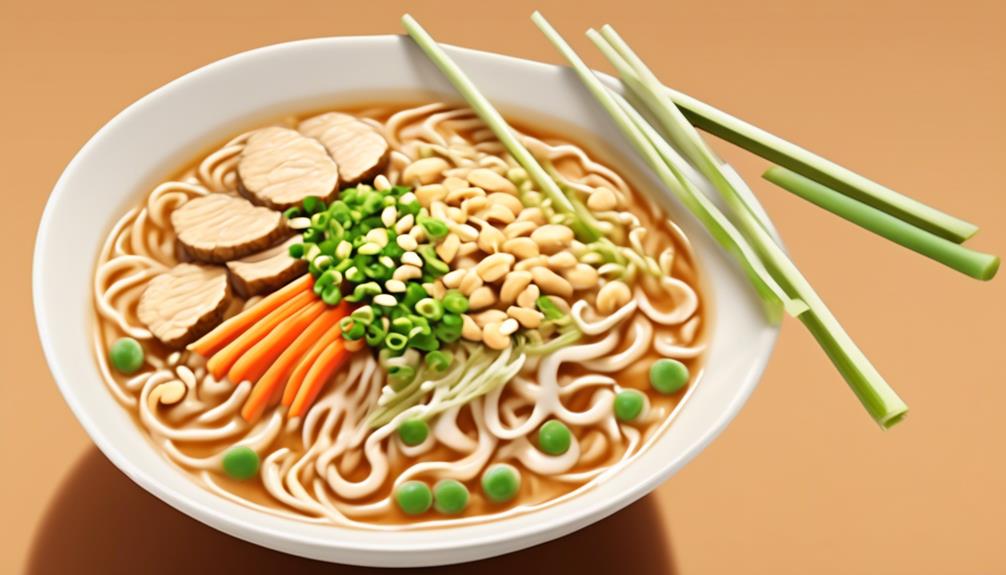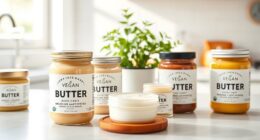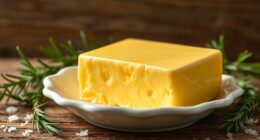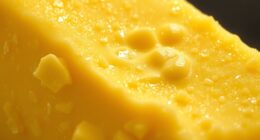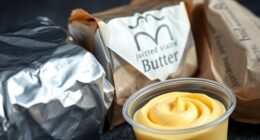Ever thought about what peanut butter actually tastes like? It’s more than just a mix of peanuts and butter.
The taste of peanut butter is a complex blend of flavors that is both familiar and unique. From its creamy texture to its nutty undertones, there's a lot to explore when it comes to the flavor profile of this beloved spread.
But there's more to it than just the taste itself. Join us as we delve into the world of peanut butter and uncover the nuances that make it a staple in so many pantries and a favorite among snack enthusiasts.
Key Takeaways
- Peanut butter has a rich, nutty flavor with a hint of sweetness and nutty undertones that add depth and complexity.
- It has a smooth, creamy texture that offers a luscious and indulgent mouthfeel, with options for both creamy and crunchy varieties.
- Peanut butter is a versatile ingredient that enhances flavors and textures in both sweet and savory dishes, pairing well with ingredients like jelly, honey, soy sauce, ginger, chili, and chocolate.
- There is a difference between artisanal and commercial peanut butter, with artisanal varieties using high-quality, natural ingredients and offering a richer, more complex flavor, while commercial varieties are mass-produced and have a processed, uniform taste with a smoother, homogenized texture.
Peanut Butter Flavor Profile
Peanut butter delivers a rich, nutty flavor with a hint of sweetness and a smooth, creamy texture, making it a versatile ingredient for both sweet and savory dishes.
The peanut flavor is distinct, offering a delightful blend of savory and sweet notes that tantalize the taste buds. It contains healthy fats that contribute to its luscious, velvety texture, making it a delightful addition to smoothies, sauces, and baked goods.
When exploring the types of peanut butter, one encounters options like natural peanut butter, which contains no added sugar or preservatives, and the traditional variety that may include added sugar for a sweeter taste. The natural peanut butter captures the pure essence of peanuts, enhancing the depth of its flavor profile.
This delectable spread also appeals to those seeking delicious vegan options, making it a versatile choice for a wide range of dietary preferences.
Whether enjoyed on its own, paired with fruits, or integrated into savory dishes, peanut butter's complexity and texture make it a perennial favorite.
Sweetness and Saltiness

Balancing sweetness and saltiness in peanut butter is essential to creating a harmonious flavor profile that enhances its complexity and versatility in culinary applications. When it comes to the taste of peanut butter, the amount of sugar and salt it contains plays a crucial role in defining its flavor.
Here's what we know about the sweetness and saltiness of peanut butter:
- Varied Balance: The balance of sweetness and saltiness can differ among peanut butter brands and types, offering a range of flavor profiles to suit different preferences.
- Sweetness Source: The sweetness in peanut butter comes from added sugars, contributing to its rich, sweet taste that pairs exceptionally well with various ingredients in both sweet and savory recipes.
- Saltiness Component: On the other hand, the salt content in peanut butter provides a contrasting savory element, adding depth and enhancing the overall flavor complexity.
- Versatile Ingredient: The carefully calibrated balance of sweetness and saltiness makes peanut butter a versatile ingredient, capable of elevating the taste of everything from desserts to marinades and sauces.
Nutty Undertones

With its rich and earthy flavor, peanut butter entices the palate with nutty undertones that add depth and complexity to its taste profile.
The nutty undertones in peanut butter give it a distinctive savory quality, enhancing its overall taste with a hint of sweetness.
When indulging in a taste test, one can't help but notice the satisfying and comforting flavor experience brought about by these nutty undertones.
They contribute to the versatile nature of peanut butter, making it suitable for a wide range of dishes, both sweet and savory.
The nutty undertones create a delightful texture and aroma, elevating the overall sensory experience of enjoying peanut butter.
Whether spread on toast, blended into a smoothie, or used as a dip for fruits and vegetables, the nutty undertones of peanut butter play a vital role in its allure.
They infuse every bite with a warm, nutty essence that lingers on the taste buds, leaving a lasting impression of flavorful satisfaction.
Creamy Vs. Crunchy Texture

As we explore the sensory experience of peanut butter, the interplay between its creamy and crunchy textures adds an intriguing dimension to its overall appeal. When it comes to peanut butter, the texture plays a significant role in shaping our perception of this beloved spread.
Here's how the creamy vs. crunchy texture debate unfolds:
- Creamy Texture: The smooth, velvety consistency of creamy peanut butter creates a luscious and indulgent mouthfeel. It effortlessly glides across the palate, offering a uniform sensation that's comforting and rich.
- Crunchy Texture: On the other hand, crunchy peanut butter introduces an element of surprise with its delightful crunchiness. The small, satisfying peanut pieces scattered throughout the spread provide a contrast in texture, adding an exciting dimension to each bite.
- Personal Preference: The choice between creamy and crunchy often boils down to personal preference. Some may favor the luxurious creaminess, while others enjoy the playful textural variation offered by crunchy peanut butter.
- Versatility: Both creamy and crunchy peanut butter excel in different culinary applications, offering unique textural experiences in everything from sandwiches and desserts to savory sauces and smoothies.
Aromatic Notes

When it comes to peanut butter, the aromatic notes are a crucial aspect of its overall sensory experience.
The various scents and odors associated with peanut butter can range from nutty and earthy to slightly sweet and roasted.
Understanding these aromatic notes allows us to appreciate the complexity and depth of flavor in this beloved spread.
Flavor Profile
- Complex flavor profile with savory and sweet notes
- Aromatic notes of rich, roasted nuttiness
- Subtle hint of salt enhancing the overall taste experience
- Velvety smooth texture
- Crunchy variety adding an extra layer of depth
- Warm and inviting aroma
- Versatile flavor profile that enhances a wide range of culinary creations.
Texture and Consistency
Exploring the sensory experience of peanut butter, we uncover the rich and indulgent aroma that accompanies its velvety texture and creamy consistency. The aromatic notes of peanut butter are nutty and slightly sweet, evoking a comforting and indulgent aroma. The consistency of peanut butter can range from silky and velvety in smooth varieties to crunchy and satisfying in chunky versions. When opened, the rich aroma of roasted peanuts is released, accompanied by a hint of sweetness from natural sugars. The texture of peanut butter lends itself well to both sweet and savory applications, making it a versatile ingredient with a satisfying mouthfeel.
| Texture | Aromatic Notes |
|---|---|
| Thick and creamy | Nutty and sweet |
| Smooth and spreadable | Comforting and indulgent |
| Versatile mouthfeel | Rich roasted peanuts aroma |
Sweet Versus Savory
Comparing the sweet and savory aromatic notes of peanut butter reveals a complex and versatile flavor profile that enhances both sweet and savory dishes. The interplay between the sweet and savory elements creates a rich and multidimensional experience for the taste buds.
When enjoying peanut butter, one can expect to encounter a delightful balance of sweet overtones and savory undertones, making it a truly versatile ingredient. The sweet aromatic notes evoke flavors akin to honey, caramel, and vanilla, while the savory notes bring out the roasted, nutty, and earthy essence.
This harmony of aromas adds depth and character to peanut butter, making it suitable for an array of culinary applications. Whether used in sweet desserts or savory sauces, the aromatic notes of peanut butter elevate the overall dining experience.
Umami Elements

Umami elements infuse a rich and satisfying depth of flavor, enhancing the complexity, texture, and aroma of the foods they're found in. When it comes to peanut butter, umami elements play a crucial role in defining its unique taste. The savory richness of peanuts, combined with the toasty, nutty notes, creates a delectable umami profile that lingers on the palate. This savory taste sensation adds a layer of depth to the overall flavor, making peanut butter not just sweet, but also deeply satisfying.
The umami elements in peanut butter contribute to its creamy texture, giving it a smooth and velvety mouthfeel. This combination of savory and creamy textures creates a truly indulgent experience, making it a versatile ingredient that pairs well with both sweet and savory dishes.
The aroma of peanut butter is also enhanced by these umami elements, evoking a comforting and inviting scent that's instantly recognizable.
Incorporating umami-rich peanut butter into recipes can elevate the overall flavor profile, adding a satisfying and mouthwatering dimension to dishes, whether it's used in savory sauces, marinades, or even desserts. The umami elements in peanut butter truly make it a multifaceted and irresistibly delicious ingredient.
Mouthfeel Experience

When we scoop a spoonful of peanut butter, we anticipate a creamy, velvety mouthfeel that coats the palate with richness and satisfaction.
The smooth, slightly sticky texture delivers a comforting sensation as it glides across the tongue, while the contrast of crunchy peanut butter adds an enjoyable textural element.
The mouthfeel experience of peanut butter greatly impacts its overall enjoyment, influencing factors such as spreadability, creaminess, and the feeling of thickness.
Creamy Texture Sensation
With its smooth and velvety texture, creamy peanut butter delivers a rich and indulgent mouthfeel sensation that coats the palate with a lush and buttery consistency. When savored, the creamy peanut butter provides a satisfyingly dense and spreadable sensation that glides effortlessly across the tongue.
The luxurious mouthfeel experience is akin to a sumptuous and velvety spread, offering a delightful and smooth consistency that melts in the mouth. Each bite of creamy peanut butter creates a comforting and pleasurable sensation, like indulging in a thick, indulgent paste.
This sensation is truly unique, providing a sensation that's both satisfying and decadent.
- Smooth and velvety texture
- Dense and spreadable sensation
- Sumptuous and velvety spread
- Comforting and pleasurable sensation
Sticky and Smooth
The transition from discussing the creamy texture sensation to exploring the sticky and smooth mouthfeel experience of peanut butter reveals a shift in the sensory journey, as the velvety richness gives way to a cohesive and adhesive sensation that lingers with comforting smoothness.
When indulging in peanut butter, the sticky and smooth mouthfeel envelops the palate with a luxurious and seamless feel. It coats the mouth with a pleasing and adhesive sensation, akin to a thick, indulgent texture that glides effortlessly, leaving a comforting smoothness in its wake.
The peanut butter's ability to adhere to the roof of the mouth and tongue creates a rich and satisfying sensation, evoking a sense of satisfaction and comfort. This cohesive and velvety texture offers an intimate experience, leaving a lasting impression of indulgence and satisfaction.
Rich and Satisfying
Indulging in the rich and satisfying mouthfeel of peanut butter envelops the palate with a luxurious and seamless feel, offering a deeply gratifying sensation. The complexity of this experience is unparalleled, as the creamy and dense consistency delivers a full-bodied and indulgent feeling that lingers on the palate.
The texture is smooth, buttery, and velvety, creating a sense of fullness and intensity that's both substantial and fulfilling. The aroma of rich and satisfying peanut butter evokes a comforting and decadent sensation, akin to a sumptuous, creamy indulgence that leaves a lasting and delightful impression.
It's like a luxurious treat that satisfies the senses in a deeply gratifying way, making each bite or spread an exquisite experience.
Lingering Aftertaste

Experiencing a lingering aftertaste can significantly impact our overall enjoyment of peanut butter, as it has the potential to enhance or detract from the initial taste and influence subsequent flavor pairings. When savoring the lingering aftertaste of peanut butter, we might notice its rich, nutty complexity lingering on the palate, adding depth and a sense of satisfaction. This lingering aftertaste can elevate the overall texture and aroma of the experience, making it a memorable part of enjoying peanut butter.
For those who've never tried peanut butter, the lingering aftertaste can be a revelation. It goes well beyond the initial taste, leaving a comforting sensation that often leads to a newfound appreciation for this beloved spread. Different popular brands of peanut butter may offer varying lingering aftertastes, from a creamy finish to a slightly roasted note, adding to the overall complexity of the experience.
Moreover, the lingering aftertaste of peanut butter can greatly influence flavor pairings. Whether it's the classic combination of peanut butter and jelly, the indulgent richness of peanut butter with brown butter, the savory twist of peanut sauce, or even the unexpected delight of peanut butter paired with tomato sauce, the lingering aftertaste can either harmonize or contrast with other flavors, shaping the overall enjoyment of the culinary experience.
Harmony of Ingredients

As we explore the harmony of ingredients in peanut butter, we uncover a symphony of flavors that enhance the overall taste experience. The complexity of peanut butter's flavor profile is a result of the careful balance of its ingredients, creating a delightful and satisfying sensation for our taste buds.
- Rich Nuttiness: The natural richness of peanuts shines through, creating a deep, nutty flavor that forms the foundation of peanut butter's taste.
- Perfect Sweetness and Saltiness: The interplay of sweetness and saltiness in Harmony of Ingredients peanut butter is perfectly calibrated, elevating the overall taste and creating a harmonious balance.
- Smooth and Creamy Texture: The texture of this peanut butter is velvety and luxurious, allowing it to effortlessly glide on the palate, enhancing the overall experience.
- Pure and Authentic Ingredients: The high-quality, natural ingredients used in Harmony of Ingredients peanut butter ensure a pure and authentic taste, free from added sugars, oils, or preservatives.
The aroma of freshly ground peanuts combined with the balanced sweetness and saltiness creates a sensory experience that's both comforting and indulgent. This harmony of ingredients underscores the exceptional nature of peanut butter, making it a versatile and beloved addition to our culinary repertoire.
Versatility in Culinary Use

Peanut butter's versatility in culinary use adds depth and richness to a wide array of dishes, enhancing their flavors and textures with its creamy and nutty profile. Its ability to straddle the line between sweet and savory makes it a valuable addition to the kitchen.
The creamy texture and nutty aroma of peanut butter make it an ideal ingredient for both sweet and savory recipes. Whether it's used in a spicy curry to add a hint of sweetness and creaminess or in a decadent dessert to provide a rich, nutty undertone, peanut butter elevates the dish to new heights.
As a dip, spread, or even a baking substitute for oil or butter, peanut butter's flexibility knows no bounds. It seamlessly integrates into recipes, bringing its unique flavor to the forefront while complementing other ingredients.
The versatility of peanut butter extends across various cuisines, effortlessly pairing with a range of flavors from spicy to umami. Its culinary use is truly multifaceted, making it a kitchen essential for creating dishes with complexity and depth.
Pairing Combinations

Incorporating peanut butter into various pairing combinations amplifies the complexity and depth of flavors in culinary creations, allowing for a range of sweet and savory profiles to emerge. When exploring the world of peanut butter pairing combinations, we find that:
- Classic Sweet Pairings: Peanut butter harmonizes exquisitely with sweet flavors such as jelly, honey, or bananas, creating a timeless and comforting taste sensation.
- Savory Innovations: For those seeking a savory adventure, try combining peanut butter with ingredients like soy sauce, ginger, or chili to craft a delightful umami-rich flavor that tantalizes the taste buds.
- Decadent Indulgence: Chocolate and peanut butter form a heavenly alliance, whether in luscious desserts like brownies or as a delectable spread on toast, offering a symphony of rich and indulgent flavors.
- Fruitful Delights: The nutty essence of peanut butter finds perfect companionship with fruits such as apples, strawberries, and raspberries, introducing a refreshing element to the pairing and elevating the sensory experience.
These pairings showcase the versatility and charm of peanut butter, inviting us to savor a symphony of flavors that dance harmoniously on our palates.
Artisanal Vs. Commercial Varieties

When comparing artisanal and commercial varieties, the complexity, texture, and aroma of peanut butter reveal distinctive differences in their production processes and ingredient quality.
| Aspect | Artisanal Peanut Butter | Commercial Peanut Butter |
|---|---|---|
| Ingredients | High-quality, natural | Mass-produced, added preservatives and stabilizers |
| Flavor | Rich, complex | Processed, uniform |
| Texture | Creamier, less gritty | Overly smooth, homogenized |
Artisanal peanut butter is crafted in small batches, using premium, natural ingredients, resulting in a richer, more complex flavor profile. The roasting and grinding process in artisanal production also contribute to a creamier, less gritty texture, providing a more indulgent sensory experience. In contrast, commercial peanut butter, mass-produced with preservatives and stabilizers, often offers a more uniform and processed taste and texture. These differences in production methods and ingredient quality lead to a noticeable distinction in aroma and overall taste. The result is that while artisanal varieties may have a shorter shelf life and a higher price point, they offer a more authentic and intimate peanut butter experience, highlighting the craftsmanship and dedication to quality.
Historical Evolution of Taste

As peanut butter consumption grew in popularity over the years, its taste has evolved to encompass a wider range of flavors and textures, reflecting changes in production methods and ingredient preferences. The historical evolution of taste in peanut butter is a fascinating journey that has been influenced by various factors. Here are some key aspects that have shaped the evolution of peanut butter taste:
- Roasting Techniques: The evolution of roasting techniques has added complexity to the flavor profile of peanut butter, ranging from light and nutty to deep and rich.
- Ingredient Variations: The use of different types of peanuts and the introduction of additional ingredients such as honey, sea salt, and different oils have contributed to a diverse texture and flavor experience.
- Aroma Enhancement: Modern production methods focus on preserving the natural aroma of peanuts, resulting in a more aromatic and inviting peanut butter experience.
- Flavor Pairings: The historical evolution of taste has seen peanut butter being paired with a variety of flavors such as chocolate, fruits, and spices, creating a harmonious blend of complementary tastes.
Understanding the historical evolution of taste in peanut butter provides insight into the complex and dynamic nature of this beloved spread.
Personal Preferences and Tasting Tips

When it comes to peanut butter, our personal preferences play a significant role in our enjoyment of this beloved spread. From the complexity of flavor profiles to the texture and consistency, there's a wide range of factors that influence our individual tastes.
As we explore the world of peanut butter, it's essential to consider our unique preferences and tasting tips to truly savor this versatile treat.
Flavor Profiles
Exploring the diverse flavor profiles of peanut butter reveals a complex interplay of nuttiness, sweetness, and savory notes, offering a rich sensory experience for taste aficionados.
When considering the flavor profiles of peanut butter, it's essential to appreciate the following:
- Nutty and Sweet: The nuttiness of peanut butter is complemented by a subtle sweetness, creating a delightful balance of flavors that can be enjoyed on its own or paired with sweet ingredients like honey or fruit preserves.
- Savory and Salty: Some varieties of peanut butter offer savory undertones with a hint of saltiness, making them a versatile addition to savory dishes like stir-fries or satay sauces.
- Creamy vs. Crunchy: The texture of peanut butter, whether creamy or crunchy, can significantly influence the overall flavor experience, catering to different preferences for smoothness and crunchiness.
- Versatile Pairings: Whether used in sweet treats or savory recipes, peanut butter's flavor adapts and complements a wide range of dishes, making it a beloved pantry staple for many.
Texture and Consistency
Considering the intricate interplay of nuttiness, sweetness, and savory notes in peanut butter's flavor profiles, our exploration now shifts toward personal preferences and tasting tips for its texture and consistency. When it comes to peanut butter, the texture and consistency can greatly influence the overall experience. Some may prefer a smooth and creamy texture, while others relish the added crunch and texture of chunky peanut butter. To help navigate these preferences, it's essential to consider the desired texture and consistency when tasting peanut butter, especially for specific uses like spreading, baking, or snacking. Below is a table summarizing the various textures and consistencies of peanut butter to cater to different preferences:
| Texture/Consistency | Description |
|---|---|
| Creamy | Smooth and uniform texture |
| Crunchy | Contains small peanut pieces |
| Extra Crunchy | Contains larger, more abundant peanut pieces |
Experimenting with these different options can help determine the preferred texture that best complements the overall peanut butter experience.
Frequently Asked Questions
Does Peanut Butter Taste Good?
Peanut butter tastes fantastic! Its nutty, sweet, savory flavors blend perfectly, and the smooth, creamy texture is so satisfying.
Plus, it's so versatile, pairing well with both sweet and savory dishes. Whether you prefer a smooth or crunchy variety, there's something for everyone.
Personal preference definitely plays a role, but overall, it's a delicious spread that adds depth and richness to any dish.
How Do You Describe Peanut Butter Taste?
Peanut butter taste is like a creamy blend of roasted nuts, with a hint of sweetness and a satisfyingly smooth texture. It has a rich, nutty aroma and a comforting, indulgent feel on the palate.
It's a complex mix of savory and sweet that creates a comforting and familiar experience. We can't get enough of it on toast or with a spoon straight from the jar.
What Kind of Flavor Is Peanut Butter?
Peanut butter offers a unique blend of nuttiness, sweetness, and a hint of saltiness. Its creamy, smooth texture adds to the overall experience.
The versatility of its taste makes it perfect for both sweet and savory dishes. This combination of flavors and textures creates a delightful complexity that tantalizes the senses.
It's no wonder why we find it so irresistible.
How Do I Start Liking Peanut Butter?
We can share some tips on how to start liking peanut butter.
First, try incorporating small amounts into your favorite recipes or meals. Experiment with different brands and flavors to find one that suits your taste preferences.
Consider using natural peanut butter with minimal added ingredients for a more authentic flavor. Pair it with fruits, honey, or chocolate to enhance its taste.
Being open to trying different forms, like creamy or crunchy, can also help.
Conclusion
In conclusion, the taste of peanut butter is like a symphony of creamy, nutty, and slightly sweet notes that dance on your taste buds. It's like a flavor explosion that leaves you craving for more with every bite.
The texture is as smooth as silk, and the aroma is like a warm, comforting hug.
Peanut butter is a true masterpiece of flavor that will leave you wanting more.
